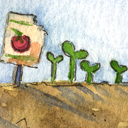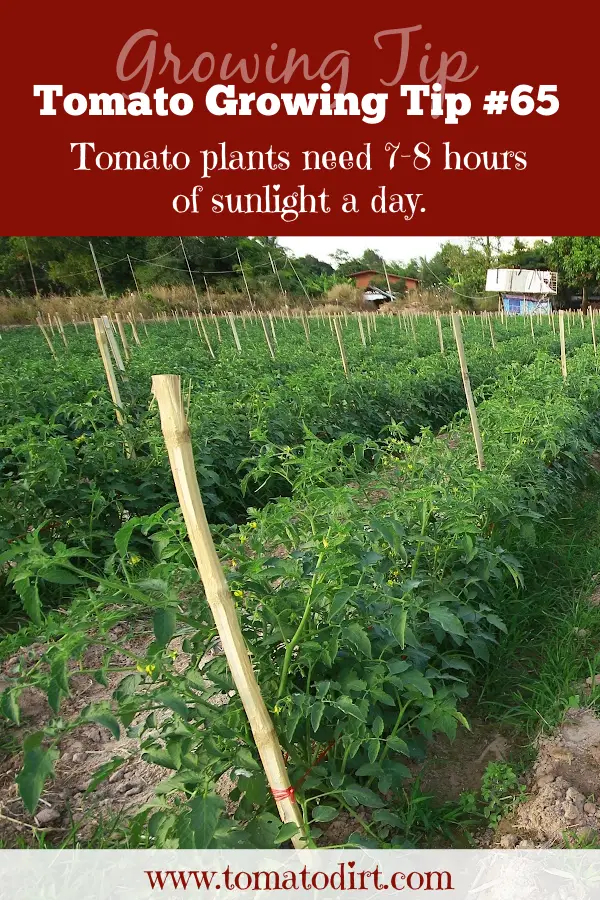Growing Tomatoes: Top 4 Areas of Tomato Care After Planting
Since 2010, Tomato Dirt has garnered 4.8+ million views, making it the web’s leading online source for growing tomatoes in the home garden. Award-winning writer and Tomato Dirt owner Kathy Widenhouse has helped thousands of home gardeners grow healthier tomatoes. Be one of them when you get Tomato Dirt’s Growing Guide here.
Updated 7.10.25
Growing tomatoes is fun! Once your tomato plants are in a well-prepared garden that gets at least 7-8 hours of sunlight a day, much of the heavy work is done. Now you can focus your attention on four important areas of tomato care to make sure you get the best results from your crop.
Tomato Care Step #1: Watering
When it comes to growing tomatoes, you need to know two things about watering them.
- Tomatoes need 1-3 inches of water a week, depending on temperatures.
- Tomatoes need consistent watering (rather than daily or sporadic watering).
Regular watering not only helps plants thrive, but also helps prevent many tomato diseases, cracking, and blossom-end rot.
Do your crop and yourself a favor by establishing a consistent watering schedule.
It’s not hard. It just takes a little bit of planning and an eye on the weather radar each week.
You can also help your growing tomatoes maintain a healthy moisture balance when you apply mulch 3-5 weeks after planting (and no earlier).
More about Watering Tomatoes
Watering tomato plants – the basics ...
Watering tomatoes when planting and just afterwards ...
Watering tomatoes: FAQs (Frequently Asked Questions) ...
Techniques for watering tomato plants ...
How and when to mulch tomatoes ...
What's the best mulch for growing tomatoes?
Tomato Care Step #2: Fertilizing

Tomatoes are fast growers. They require significant amounts of nutrients to put out branches, develop blossoms, and form fruit – all in just a few short weeks. The tomato fertilizer you added when planting will last only a short time. Help your growing tomatoes thrive by continuing to give them the nutrients they need.
Apply tomato fertilizer once fruit is set and every 3-4 weeks afterward. Create a simple feeding schedule. You can also coordinate watering and fertilizing schedules to simplify tomato care.
More about Fertilizing Tomatoes
How to use tomato fertilizer for best tomato production ...
Kinds of tomato fertilizer ...
Organic tomato fertilizer: advantages and disadvantages...
Tomato Care Step #3: Staking
Staking your tomatoes isn’t 100% necessary, especially if you’re growing tomatoes of a dwarf or bush variety. But for most indeterminate tomatoes, staking means the difference between a larger, healthier crop and a so-so one.
Staking can be a one-time step when you use tomato cages, tomato spirals, or even a tomato trellis. Tomato stakes, on the other hand, while less expensive still require that you check plants at least once a week and tie new branches to the stake for support.
This is one area of tomato care that requires you to make a decision fairly soon after planting. Growing tomatoes don’t wait for you to stake them. Try different ways of staking tomatoes and find out which method works for you. You can also choose a combination of tomato staking methods, using cages for some tomatoes and stakes for others, for instance.
More about Staking Tomatoes
Best methods for staking tomatoes ...
How to stake and tie tomatoes for support ...
How to build tomato cages for support ...
How to build a tomato trellis for staking tomatoes ...
Tomato Care Step #4: Monitoring
Tomatoes are the most popular home garden crop in the U.S. Unfortunately, tomatoes are also extremely popular with garden pests.
The good news is that with just a little diligence, you can help keep your tomatoes healthy, disease-free, and pest-free.
Make it a habit to monitor your tomato plants daily if possible. Stroll by plants each day and do a quick inspection. Look for wilting leaves, discolored leaves, holes in leaves, streaked stems or leaves, and holes in fruit. Those symptoms can indicate a number of different tomato problems, including tomato diseases (such as tomato blight, blossom-end rot, or tomato fungus). You’ll also be able to spot tomato bugs and pests (like the tomato hornworm or cutworm.)
When you keep a regular eye on your tomatoes and see problems, you’ll be able to treat them right away. That means healthy tomato plants and a big crop of juicy, best tasting tomatoes.
More on growing tomatoes
Why Tomatoes Are One of the Easiest Vegetables to Grow ...
Best tomato growing tips: readers share their favorites ...
Use This 6-Step Checklist for Tomato Plant Care ...
The 6 Tomato Growing Stages Explained ...
How to Increase Flowering in Tomatoes ...
How Do You Ripen Tomatoes on the Vine Faster?
10 Tips for Growing Tomatoes in Hot Weather ...
Green Tomatoes: A Gardener’s Q & A ...
Grafted tomatoes: what are they and why grow them?
How To Make Tomato Plants Grow Faster ...
Growing tomatoes in raised beds ...
How to control weeds in the tomato garden ...
Pruning tomato plants: how and when to do it ...
How to grow tomatoes in pots or containers ...
Growing cherry tomatoes in containers or pots ...
Best and worst companion plants for tomatoes ...
10 companion plants that protect tomatoes from pests ....
Get more tips on our Tomato Growing Tips Pinterest board...
Return from Growing Tomatoes to Tomato Dirt home
As an Amazon Associate and Rakuten Advertising affiliate I earn from qualifying purchases.
SHARE THIS PAGE:
FREE! 10 Must-Know Tomato Growing Tips: 20-page guide
Get yours here:





New! Comments
Have your say about what you just read! Leave a comment in the box below.